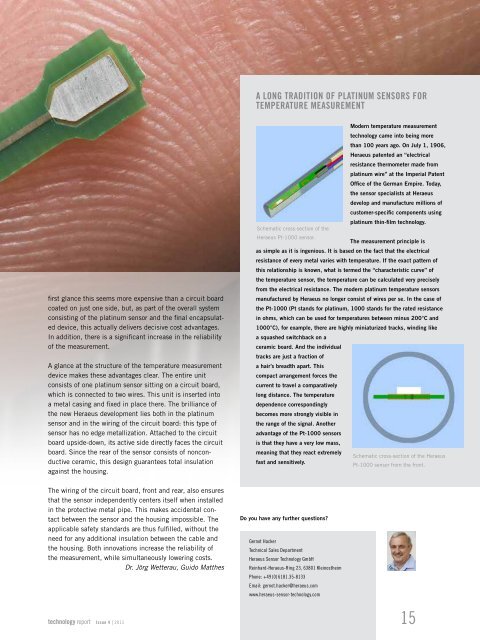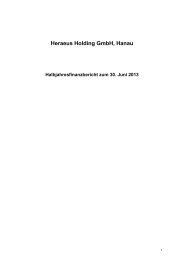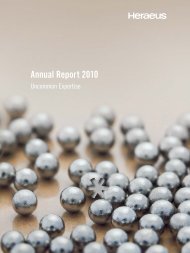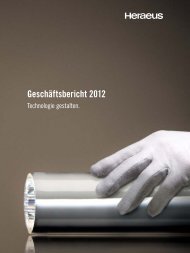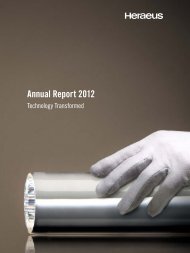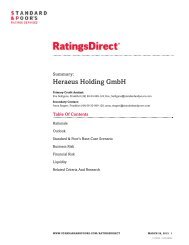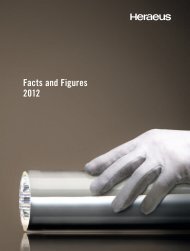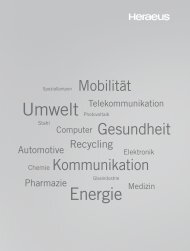technology report 04
technology report 04
technology report 04
Create successful ePaper yourself
Turn your PDF publications into a flip-book with our unique Google optimized e-Paper software.
A long tradition of platinum sensors for<br />
temperature measurement<br />
first glance this seems more expensive than a circuit board<br />
coated on just one side, but, as part of the overall system<br />
consisting of the platinum sensor and the final encapsulated<br />
device, this actually delivers decisive cost advantages.<br />
In addition, there is a significant increase in the reliability<br />
of the measurement.<br />
A glance at the structure of the temperature measurement<br />
device makes these advantages clear. The entire unit<br />
consists of one platinum sensor sitting on a circuit board,<br />
which is connected to two wires. This unit is inserted into<br />
a metal casing and fixed in place there. The brilliance of<br />
the new Heraeus development lies both in the platinum<br />
sensor and in the wiring of the circuit board: this type of<br />
sensor has no edge metallization. Attached to the circuit<br />
board upside-down, its active side directly faces the circuit<br />
board. Since the rear of the sensor consists of nonconductive<br />
ceramic, this design guarantees total insulation<br />
against the housing.<br />
The wiring of the circuit board, front and rear, also ensures<br />
that the sensor independently centers itself when installed<br />
in the protective metal pipe. This makes accidental contact<br />
between the sensor and the housing impossible. The<br />
applicable safety standards are thus fulfilled, without the<br />
need for any additional insulation between the cable and<br />
the housing. Both innovations increase the reliability of<br />
the measurement, while simultaneously lowering costs.<br />
Dr. Jörg Wetterau, Guido Matthes<br />
<strong>technology</strong> <strong>report</strong> Issue 4 | 2013<br />
Modern temperature measurement<br />
<strong>technology</strong> came into being more<br />
than 100 years ago. On July 1, 1906,<br />
Heraeus patented an “electrical<br />
resistance thermometer made from<br />
platinum wire” at the Imperial Patent<br />
Office of the German Empire. Today,<br />
the sensor specialists at Heraeus<br />
develop and manufacture millions of<br />
customer-specific components using<br />
platinum thin-film <strong>technology</strong>.<br />
Schematic cross-section of the<br />
Heraeus Pt-1000 sensor.<br />
The measurement principle is<br />
as simple as it is ingenious. It is based on the fact that the electrical<br />
resistance of every metal varies with temperature. If the exact pattern of<br />
this relationship is known, what is termed the “characteristic curve” of<br />
the temperature sensor, the temperature can be calculated very precisely<br />
from the electrical resistance. The modern platinum temperature sensors<br />
manufactured by Heraeus no longer consist of wires per se. In the case of<br />
the Pt-1000 (Pt stands for platinum, 1000 stands for the rated resistance<br />
in ohms, which can be used for temperatures between minus 200°C and<br />
1000°C), for example, there are highly miniaturized tracks, winding like<br />
a squashed switchback on a<br />
ceramic board. And the individual<br />
tracks are just a fraction of<br />
a hair’s breadth apart. This<br />
compact arrangement forces the<br />
current to travel a comparatively<br />
long distance. The temperature<br />
dependence correspondingly<br />
becomes more strongly visible in<br />
the range of the signal. Another<br />
advantage of the Pt-1000 sensors<br />
is that they have a very low mass,<br />
meaning that they react extremely<br />
Schematic cross-section of the Heraeus<br />
fast and sensitively.<br />
Pt-1000 sensor from the front.<br />
Do you have any further questions?<br />
Gernot Hacker<br />
Technical Sales Department<br />
Heraeus Sensor Technology GmbH<br />
Reinhard-Heraeus-Ring 23, 63801 Kleinostheim<br />
Phone: +49(0)6181.35-8133<br />
Email: gernot.hacker@heraeus.com<br />
www.heraeus-sensor-<strong>technology</strong>.com<br />
15


